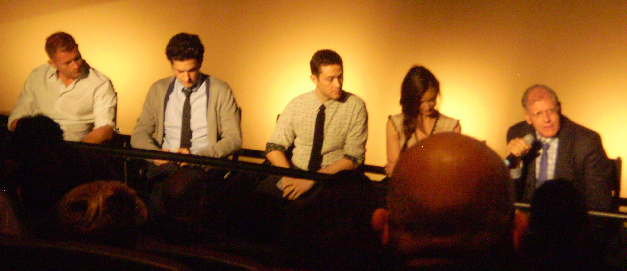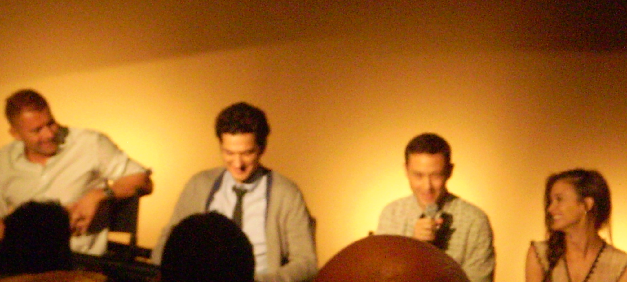Dedicatedly embarking on an unexplored and unfamiliar journey, in a courageous attempt to overcome your fears and prove your worth and abilities, can be a frightening prospect for many people. But French high-wire artist Philippe Petit’s decision to walk between the Twin Towers of the World Trade Center, particularly while they were being constructed during the mid-1970s, was an alluring choice that proves that people don’t have to follow society’s expectations and norms in order to thrive. His powerful journey is intriguingly presented in the upcoming biographical drama, ‘The Walk,’ which was directed by Robert Zemeckis, who also co-wrote the script with Christopher Browne. The movie, which is based on Petit’s 2002 book, ‘To Reach the Clouds,’ screened for the press yesterday morning at the 53rd New York Film Festival, before it had its world premiere last night. Joined by several of the drama’s main stars, including Joseph Gordon-Levitt, Charlotte Le Bon, James Badge Dale and Ben Schwartz, during a press conference at the AMC Loews Lincoln Square in Manhattan, the filmmaker and actors discussed the allure of bringing Petit’s story to the public’s attention through the film.
‘The Walk,’ which opens in limited IMAX release on Wednesday, before it receives a wide theatrical distribution from Sony Pictures Releasing on October 9, follows Philippe (Gordon-Levitt), a Frenchman who moves to Paris as a young adult to further his interest in magic and performing. After first witnessing wire walking as a child, he immediately took an interest in pursuing the craft himself. He was taken under the guidance of Papa Rudy (Ben Kingsley) after he was caught sneaking into the famed performer’s circus, and ultimately proved his juggling skills. As Philippe becomes more determined to master high-wire walking himself, he also sets out to find the perfect place to put his wire, and prove his talent to the world. After reading an article about the construction of the Twin Towers at the World Trade Center in New York City, Philippe becomes driven during the summer of 1974 to walk between the buildings before their manufacturing is complete. With the help of his mentor, his girlfriend Annie (Le Bon) and a team of close friends and new associates (Dale and Schwartz), Philippe sets out to pull off his coup and walk across his wire 110 stories up, with audiences in one of the world’s greatest cities watching him.
Zemeckis was the first to comment on the making of ‘The Walk’ during the drama’s press conference at the New York Film Festival, saying he first began developing Petit’s story into a film 10 years ago. “I came across a children’s book, called ‘The Man Who Walked Between the Towers,’ and became intrigued by this eight-page book,” the filmmaker revealed. While he wasn’t previously aware of the high-wire artist’s high-profile walk between the Twin Towers, the director decided to start researching what Petit did. “I thought his story was amazing, and that it had all the elements to make a compelling movie,” Zemeckis added.
When then asked how he approached playing the lead character in ‘The Walk,’ Gordon-Levitt noted that Petit “insisted that he be the one who taught me how to walk on the wire. He doesn’t do anything half-way, so he orchestrated this really elaborate workshop.” The actor spent eight straight full days working with Petit. “He said, ‘By the end of these eight days, you’ll walk on the wire by yourself,'” the film star added, before admitting that “I thought that sounded really ambitious. But he’s such a positive thinker, and he believed that I would” be able to walk on the wire on his own. With that dedicated support, Gordon-Levitt “started to believe I would. When you believe that you can do something, that’s when you can do something–and he was right. By the end of the eight days, I was able to walk on the wire by myself, and continued to practice while we shot,” the actor continued, before also elaborating that the process is “actually very fun, if painful.”
“I think everyone on the production was saying, ‘Don’t worry if you can’t really walk on the wire-it’s all going to be movie magic, anyway,'” the Emmy Award-winning actor added. “But I really wanted to learn to do it, and Philippe wanted me to learn to do it, too. While there are quite a few shots of me, I must say there are also shots of Jade Kindar-Martin, my wire walking double. He’s an excellent wire walker, as well.”
When then asked about the process of filming the wire walking scenes, Gordon-Levitt revealed that the crew built the top two stories of the Twin Towers on a soundstage, and then surrounded the sets with green screens. “They then hung the wire on the top of the set, and anchored it on a pole, and then sent it out into a green abyss. That wire was about twelve feet in the air. When I went out, I had to walk backwards to get back,” the actor added.
“Obviously, the effect that was used the most was digital painting,” Zemeckis then explained about bringing the wire walking to life on the screen. “When making this movie, I think I ended up using every special effect technique that I’ve ever used in my career, except probably cartoon animation. We mixed it up. Like any great magician or illusionist would do, you don’t want to let (the audience) see the effects, so we kept using different techniques.”
SSchwartz praised Zemeckis’ approach to telling Petit’s story of walking between the towers of the World Trade Center, particularly by admitting that the filmmaker is a hero of his. “Anything he wants me to do, I’ll do,” the actor admitted, before stating that he really connected to the overall heart of the New York story. “Not only as the script incredible, but to also have any role in telling this story seemed inspiring. It’s truly about a person who does something impossible…So it felt like we were telling a fairytale that actually happened in real life,” he further explained.
Dale emphasized his co-star’s testament when he then explained when noting why he was drawn to appearing in ‘The Walk.’ “This truly was a work of passion. I was happy to go into work every day, because Bob has this incredible energy,” the actor stated. “Joe’s also one of the kindest and most giving actors you could ever work with on a film. So we’d show up to work and always have a ton of fun.”
Le Bon then admitted that starring in ‘The Walk’ was overwhelming, as she’s just starting her acting career, and the drama’s her second major American production. She added that it was an amazing opportunity to get to work with Zemeckis and her co-stars. But she also divulged that “it was extremely difficult to learn how to play the guitar for the movie, and I hope you don’t see that. I also had to learn how to sing, which was also difficult,” the French Canadian actress revealed before emphasizing that she had a lot of fun working with the rest of the cast and crew.
The actress also praised Gordon-Levitt’s take on the Parisian French accent that he adopted for the drama. The actor laughed when he added that “What’s great about French people is that they’re totally honest-they didn’t sugar-coat anything. They’d tell me if I was making a mistake.”
With One World Trade Center opening late last year in the spot that was once occupied by the Twin Towers, Gordon-Levitt also noted that he commemorated the area by walking the distance between the site’s two memorial pools, where the towers stood before the September 11 attacks. He also visited the original observatory in 2001, during his first summer in New York City, after he finished his first year at Columbia University. “It was touristy but I wanted to go do it. I remember it distinctly. It felt more like being in the sky then being on a tall building,” the actor said.
Dale, who grew up not far from the World Trade Center site, noted that it was not only “the fabric of my childhood, but also the fabric of the city. Whether we were there, or just looking at (the buildings) from afar, they were just who we are and the city.” But he also admitted that he “couldn’t bring myself to the memorial until after we finished this film. I can’t tell you how proud I am to be a part of this film, and what it means to New York and the memory of those two towers.”
Gordon-Levitt was then asked about the difference in the process of making independent and bigger and major studio films like ‘The Walk.’ He noted that “the important thing isn’t actually the budget; it’s the motivation of the filmmaker, and everyone who’s working for the filmmaker. You can find indie movies that are derivative and trying to make a name for themselves, and you can also find studio films that have a sincere heart.”
Zemeckis then delved into his decision of releasing ‘The Walk’ in 3D, saying that when he first heard about Petit’s journey between the Twin Towers, “it just called out that it would be a 3D movie. I’ve always been searching for stories that organically lend themselves to be in 3D…In my opinion, it should be used to enhance the emotion in the story.” The writer-director emphasized that he believes that it’s a tool that filmmakers should decide to use during the very beginning of the filmmaking process, and movies should never be converted into 3D after they’re completed. “3D changes your editing pace, as well as the way your camera moves and the lenses you use. All of that has to be thought through from the beginning,” he explained.
The scribe-helmer then added that he bought Petit’s story 10 years ago, before ‘Man on Wire,’ the 2008 Oscar-winning documentary about the wire walker’s life, was made. But he praised the movie, calling it a “great documentary that lets you in to see what all the real characters were thinking, and how they did this. But the thing I always wanted to do with Philippe’s story was present the walk itself in this film. Of course, that couldn’t be done in the documentary, because no video footage of the walk was recorded.”
Watch a clip of, and check out Shockya’s exclusive photos from, ‘The Walk’s press conference at the 53rd New York Film Festival below.


Written by: Karen Benardello
